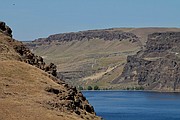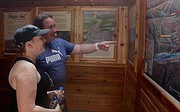Ginkgo State Park adds new renovations
VANTAGE — Just past the bridge crossing the Columbia River near Vantage, the Ginkgo Petrified Forest State Park sits nearby, holding remnants of an area carved into the landscape during the Ice Age thousands of years ago.
The park, stretching across 7,000 square acres and over 27,000 feet of shoreline, offers a unique offering of relics of the area’s geological history, as well as a host of other outdoor activities. The park is a National Natural Landmark and offers around 3 miles of hiking trails near the river basin, as well as camping, boating, and fishing, among other outdoor activities.
Recently state park staff have worked to add new renovations and updates to areas around the park, including renovations to the historic building at the entrance to the Trees of Stone interpretive trails, as well as a new solar-powered electric vehicle charging station.
The “trailside museum” at the entrance to the trails was originally built during the Great Depression by members of the Civilian Conservation Corps. The stone and wood building has been subject to years of wear and tear and water damage that had left the structure in need of repair.
Kevin Lieske works as an Interpretive Specialist for the Washington State Parks and Recreation Commission at the park. Lieske first began working in parks with the National Parks Service in Seattle at the Klondike Gold Rush Park, before moving to his current position about a year and a half ago.
Lieske said, prior to renovations, the interior of the building simply wasn’t in good condition for the public.
“Our maintenance crew spent a lot of time, either reworking what was salvageable in that area to stay, or finding a way to make it look like the original woodwork,” Lieske said.
In addition to renovations to the structure itself, new exhibit panels have been placed inside the building which help to explain some of the historic significance behind the formation of the park, petrified forest, and its discovery.
Before this, Lieske said there wasn’t much explanation about this on the trails themselves.
“With these new interpretive panels, it really provides context and a lot of meaning to what’s going on there and what took place there,” Lieske said.
The park itself receives the majority of its visitors between the period between Memorial Day all the way into October, with around 5,000 guests during just July last year. Visitors to Ginkgo Petrified Forest State Park include rock collectors, Ice Age flood enthusiasts and people simply intrigued by the park’s unique name as they pass over the bridge.
Areas of the park near the interpretive trails have been damaged by wildfires in the area in recent years, leaving portions of the trails looking like a “moonscape,” Liekse said. Luckily, no structures or objects of historical significance were lost or damaged in the fires.
Large-scale fires in the area have left areas of the park’s trails to be taken over by invasive grasses and other plants, which park officials have tried to combat with aerial seedings to instill native species back into the area.





